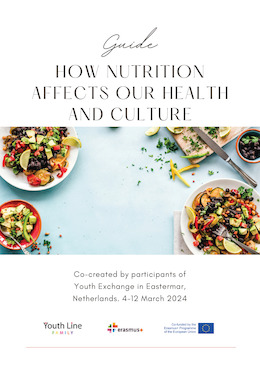Toolbox — For Training and Youth Work
All new tools in your inbox: Be the first to know about new tools for learning with our e-mail notifications.
Manual
How nutrition affects our health and culture
Our guide offers a collection of recipes that embody healthy nutritional habits and cultural heritage.
Aims of the tool
1. Promote healthy eating habits among young people and youth workers.
2. Highlight the significance of cultural heritage in nutrition.
3. Serve as a practical resource for schools, youth organizations, and community groups to improve public health.
4. Encourage the integration of nutritious diets into daily life through accessible recipes and nutritional information.
Description of the tool
This guide is an educational tool designed to enrich users' understanding of the relationship between nutrition, health, and cultural heritage. It includes a curated collection of recipes that not only emphasize healthy eating habits but also showcase the nutritional practices of different cultures.
Learning Outcomes:
1. Awareness of Nutritional Health: Users will learn to identify and prepare meals that contribute to a healthy lifestyle.
2. Cultural Appreciation: Gain an understanding of how different cultures approach nutrition, appreciating the diversity in dietary practices around the world.
3. Practical Skills: Develop practical cooking skills that can be used to maintain a balanced diet.
4. Community and Public Health Impact: Encourage the adoption of healthy eating habits within communities, contributing to broader public health goals.
Available downloads:
Disclaimer
SALTO cannot be held responsible for the inappropriate use of these training tools. Always adapt training tools to your aims, context, target group and to your own skills! These tools have been used in a variety of formats and situations. Please notify SALTO should you know about the origin of or copyright on this tool.
Tool overview

http://toolbox.salto-youth.net/4194
This tool is for
The target group for the guide includes young people, youth workers, schools, youth organizations, and community groups. These entities can use the guide to promote healthy eating habits and improve public health among their members and within their communities.
and addresses
Social Inclusion, Intercultural Learning, Personal Development, European Citizenship, Peer education
It is recommended for use in:
Youth Exchanges
Training and Networking
Materials needed:
For effective use of this nutritional guide, the following materials are required:
1. The Guide Itself: A copy of the guide, either in digital or printed format, for easy reference.
2. Cooking Utensils: Basic cooking utensils such as pots, pans, cooking spoons, and knives.
3. Kitchen Appliances: Common appliances like a stove, oven, blender, and perhaps a microwave.
4. Ingredients: Various food ingredients listed in the recipes, which may include fresh produce, spices, grains, and proteins.
5. Measuring Tools: Measuring cups and spoons for accurate ingredient portions.
6. Nutritional Information Resources: Additional resources or tools to understand and track the nutritional content of meals, such as calorie counters or apps.
7. Internet Access: For users of the digital version of the guide, as well as for accessing supplementary materials online.
8. Note-taking Materials: Notebooks or digital devices for making notes or modifications to recipes as needed.
Behind the tool
The tool was created by
Stichting Youth Line Netherlands
The tool was published to the Toolbox by
Kateryna Shepeliuk (on 13 May 2024)
and last modified
9 May 2024
Comments
No comments have been posted yet.
If you want to comment on this tool, you need to be signed in with your MySALTO account. Sign in now